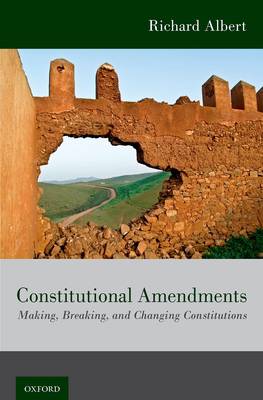
Door een staking bij bpost kan je online bestelling op dit moment iets langer onderweg zijn dan voorzien. Dringend iets nodig? Onze winkels ontvangen jou met open armen!
- Afhalen na 1 uur in een winkel met voorraad
- Gratis thuislevering in België vanaf € 30
- Ruim aanbod met 7 miljoen producten
Door een staking bij bpost kan je online bestelling op dit moment iets langer onderweg zijn dan voorzien. Dringend iets nodig? Onze winkels ontvangen jou met open armen!
- Afhalen na 1 uur in een winkel met voorraad
- Gratis thuislevering in België vanaf € 30
- Ruim aanbod met 7 miljoen producten
Zoeken
Constitutional Amendments
Making, Breaking, and Changing Constitutions
Richard Albert
Hardcover | Engels
€ 201,45
+ 402 punten
Omschrijving
Constitutional Amendments: Making, Breaking, and Changing Constitutions is both a roadmap for navigating the intellectual universe of constitutional amendments and a blueprint for building and improving the rules of constitutional change. Drawing from dozens of constitutions in every region of the world, this book blends theory with practice to answer two all-important questions: what is an amendment and how should constitutional designers structure the procedures of constitutional change? The first matters now more than ever. Reformers are exploiting the rules of constitutional amendment, testing the limits of legal constraint, undermining the norms of democratic government, and flouting the constitution as written to create entirely new constitutions that masquerade as ordinary amendments. The second question is central to the performance and endurance of constitutions. Constitutional designers today have virtually no resources to guide them in constructing the rules of
amendment, and scholars do not have a clear portrait of the significance of amendment rules in the project of constitutionalism. This book shows that no part of a constitution is more important than the procedures we use change it. Amendment rules open a window into the soul of a constitution, exposing its deepest vulnerabilities and revealing its greatest strengths. The codification of amendment rules often at the end of the text proves that last is not always least.
amendment, and scholars do not have a clear portrait of the significance of amendment rules in the project of constitutionalism. This book shows that no part of a constitution is more important than the procedures we use change it. Amendment rules open a window into the soul of a constitution, exposing its deepest vulnerabilities and revealing its greatest strengths. The codification of amendment rules often at the end of the text proves that last is not always least.
Specificaties
Betrokkenen
- Auteur(s):
- Uitgeverij:
Inhoud
- Aantal bladzijden:
- 350
- Taal:
- Engels
Eigenschappen
- Productcode (EAN):
- 9780190640484
- Verschijningsdatum:
- 12/08/2019
- Uitvoering:
- Hardcover
- Formaat:
- Genaaid
- Afmetingen:
- 163 mm x 236 mm
- Gewicht:
- 589 g

Alleen bij Standaard Boekhandel
+ 402 punten op je klantenkaart van Standaard Boekhandel
Beoordelingen
We publiceren alleen reviews die voldoen aan de voorwaarden voor reviews. Bekijk onze voorwaarden voor reviews.











